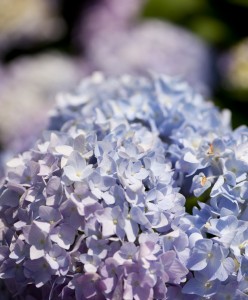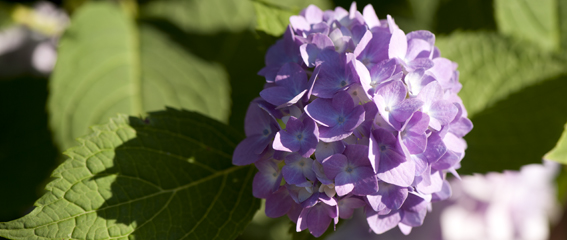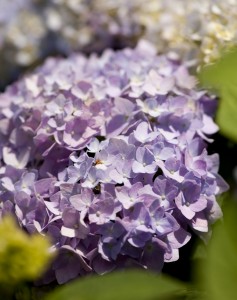Hydrangea Heydays
Posted in Around the Garden on July 17 2012, by Sonia Uyterhoeven
Sonia Uyterhoeven is the NYBG‘s Gardener for Public Education.
 The other day I was walking through Helen’s Garden of the Senses in the Home Gardening Center and I spied one of my favorite hydrangeas, Hydrangea macrophylla Mini Penny™. These days she is reaching about three feet tall and forms a solid four-foot-wide mass. A profusion of large, pale pink blooms spills over onto the walkway.
The other day I was walking through Helen’s Garden of the Senses in the Home Gardening Center and I spied one of my favorite hydrangeas, Hydrangea macrophylla Mini Penny™. These days she is reaching about three feet tall and forms a solid four-foot-wide mass. A profusion of large, pale pink blooms spills over onto the walkway.
The intricate floral structure of this mophead hydrangea means that the blossoms have incredible detail and subtle color changes. Mini Penny™ is a dwarf hydrangea that is ideal for any homeowner’s foundation planting. She plays nicely with other shrubs and perennials and adds a sophisticated flair to any garden. If you plant her, all your neighbors will think you know how to garden–even if you don’t.
Hydrangeas are fairly easy to grow. They flourish in partial shade to full sun and prefer moist, well-drained soil. Amend with organic matter such as compost before you plant and make sure that you do not over-fertilize (too much nitrogen will cause leaf growth at the expense of flowers).
Hydrangeas such as Mini Penny™ are the new, ever-blooming cultivars (Endless Summer® is another popular example) that flower on both old and new wood. Plant in a sheltered site so that the hydrangea doesn’t become desiccated during the winters, and do a judicious pruning in April where you remove just the dead and damaged branches. The buds that have formed the previous season on the old wood will flower. Deadhead once the first flush is spent and a second show on new wood will flower 10 weeks later. If you deadhead sequentially (not all at once, leaving some to age) you will have flowers on your plant for most of the summer.

Mini Penny™ is one of those hydrangeas that will change her color depending on the pH of the soil. The color of some bigleaf hydrangeas (Hydrangea macrophylla) is not only determined by cultivar, but also by the amount of aluminum in the soil, and the soil pH which determines how available aluminum is to the plant. Acidic soil, making aluminum readily available, will give you blue flowers; alkaline soil will give you pink flowers, as the aluminum is unavailable to the plants.
 But before you get too excited about picking your palette, a disclaimer: it is not always easy to manipulate the color of your hydrangea. Some of them will not change their color regardless of what you do. On the other hand, some of them will change their color and provide you with both pink and blue flowers during the same season.
But before you get too excited about picking your palette, a disclaimer: it is not always easy to manipulate the color of your hydrangea. Some of them will not change their color regardless of what you do. On the other hand, some of them will change their color and provide you with both pink and blue flowers during the same season.
To decrease the acidity of your soil (to change flowers from blue to pink), add hydrated lime to your soil in the spring. To increase the acidity of the soil (to change flowers from pink to blue), add aluminum sulfate to your soil in the spring (follow the label instructions carefully and don’t over-do it). Otherwise, pay attention to the three numbers on your fertilizer. The middle number is phosphorus. High phosphorus will help lock the aluminum in the soil providing you with a pink hydrangea while fertilizers that are low in phosphorus and high in potassium will help turn them blue.
Mini Penny™ has been with us for a number of years, and she just gets better as time goes by. Some new additions to the Home Gardening Center that are worth taking a look at are the following varieties: ‘Setsuka Yae’, ‘Adria’, ‘Merritt’s Supreme’, ‘Brestenberg’, ‘Rotschwanz’ (Teller Series), ‘Heinrich Seidel’, ‘Tokyo Delight’, and ‘Blue Danube’.

